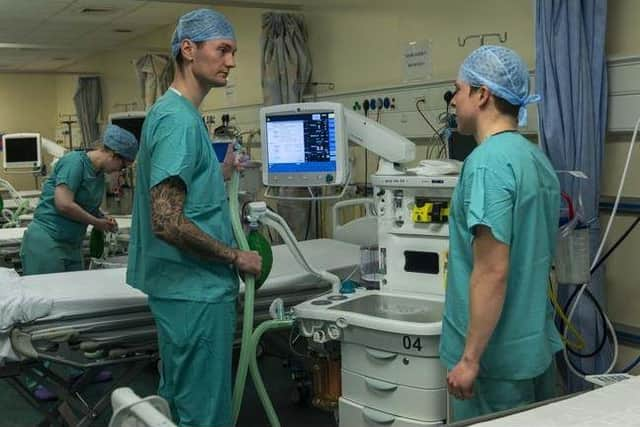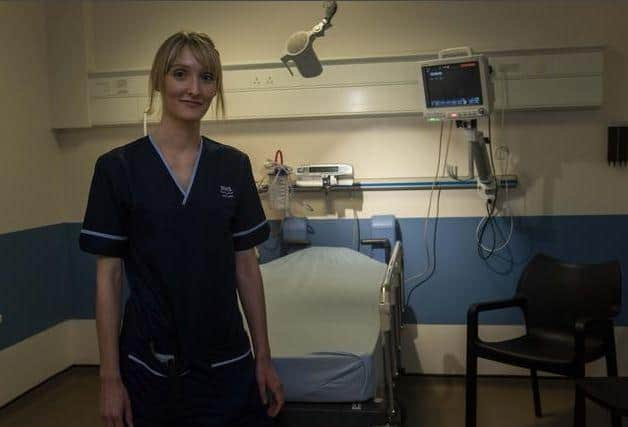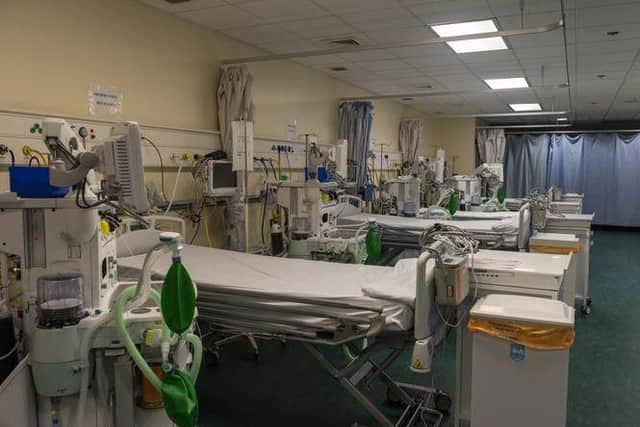This is what life is like inside one of Scotland's specialist coronavirus intensive care units
NERVOUS laughter fills the corridor as colleagues help each other painstakingly prepare for another shift.
Gloves and gowns are donned, then a second pair of gloves before friendly faces disappear behind masks and visors.
Advertisement
Hide AdAdvertisement
Hide AdMore methodical checking in the mirror before job titles are scrawled on aprons - in an emergency, knowing who’s who can make all the difference.


This is life in the Royal Infirmary’s specialist coronavirus intensive care unit.
“The main reason patients come to ICU is mainly for their breathing - so we have ventilators,” says ICU consultant Mike Gillies. “Other types of ICU support are things like dialysis.”
An entire ICU ward is now solely treating Covid-19 patients as the Royal Infirmary ramps up to meet demand.
The health board has quadrupled its capacity to treat intensive care patients to 113 - with 35-40 currently being cared for at the Royal, Western General and St John’s.


Lessons have been learned from colleagues in London which has borne the brunt of the outbreak in the UK so far.
The response is a true team effort, with the medical physics team even converting up to 50 anaesthetic machines into ventilators - and everyone can play their part.
“We’ve got ventilators and the most important thing is nursing staff and staff to look after the patients,” says Mr Gillies.
Advertisement
Hide AdAdvertisement
Hide Ad“If we get to the point of increasing sickness rates, it might become more difficult. We’d emphasise the message to stay at home and provide the support.”


A separate ICU ward is also being staffed to treat conventional cases including car crash casualties and heart attacks.
“Unfortunately, we can’t turn that work off,” says Mr Gillies, from behind a rueful smile.
READ MORE
Nurses start their 12-hour shifts donning PPE kit before heading into the ICU for a handover with colleagues on the progress of patients.
They then join a conference call with colleagues at the Western General and St John’s to discuss staffing and equipment.
Advertisement
Hide AdAdvertisement
Hide Ad“We’ll do the rounds and see every patient twice a day to make a plan for that patient for the day - drugs, ventilation and any other treatment,” says Mr Gillies.
Perhaps unsurprisingly for such an unprecedented medical response, medics are also learning as they go along.
“Sometimes we need to put patients on their front if they’re having real difficulty breathing,” says Mr Gillies. “It helps with the lungs and the blood supply - we seem to be doing more of that.”
Such painstaking work is labour intensive, of course, and so further compounds the need for fit and healthy staff with one nurse per patient in the ICU.
“It uses a lot of resource,” says senior charge nurse Lesley Triseliotis. “We have to be very careful turning over someone when they’re sick - it takes six or seven of us.”
And at every level, these extraordinary efforts are taking their toll on staff.
“The hardest thing is we normally have families of patients coming in but because of Covid-19, families haven’t been coming in - it’s very difficult for them and us,” says Ms Triseliotis.
For a profession priding itself on personal face-to-face care, having to break bad news to families remotely is proving one of the cruelest aspects of this terrible virus.
Advertisement
Hide AdAdvertisement
Hide Ad“I’ve been having difficult conversations with people on the phone,” says Mr Gillies, before selflessly switching back to the team ethos. “We’re still in the early stages of this here. We really have to be mindful of the staff and support staff and recognise the difficult jobs they’re doing. They’re going above and beyond their normal hours.”
And the generosity and support from the public has filtered through to those working away on the frontline.
“We’ve had all kinds of donations from takeaways - we’re very grateful,” said Ms Triseliotis.
“A lot of small businesses have been amazing,” adds Mr Gillies. “They’ve been sending stuff in at what is a difficult time for them - it’s been really amazing.”
No part of the hospital is untouched by the outbreak, including A&E where many suspected Covid-19 cases first arrive.
Site director Janice Alexander says: “The A&E department has been divided into two parts or zones.
“The red zone is for detecting and receiving Covid-19 patients. The green zone deals with all other patients coming to the hospital so we can care for them.”
With a spike in coronavirus cases expected, two rooms of the A&E department are being prepared to handle the influx.
Advertisement
Hide AdAdvertisement
Hide Ad“Because we’re seeing an increasing number with Covid-19, we’re increasing our footprint within the emergency department,” says Ms Alexander.
As soon as the current red zone reaches half full, the additional observation area and resuscitation unit will be brought into use.
“We’re using real time data and also projections as triggers to open areas - as soon as they’re 50 percent capacity, for example,” says Ms Alexander.
A drop-off in conventional patients in A&E has come with a rise in suspected Covid-19 cases.
“We’re quite full,” says Ms Alexander. “We’re definitely seeing an increase of patients in the hospital testing positive.
“If patients show the symptoms - coughing or a high temperature - these patients are swabbed and go into the red area and held there until the results come back.
“If the results are negative, they go to a non-Covid ward, if they’re positive, they go into a ward with other Covid patients.”
Even patients whose tests results come back clear for the virus are continuously monitored for any symptoms while in the hospital.
Advertisement
Hide AdAdvertisement
Hide Ad“Because we’re not seeing non-emergency operations carrying on, we’ve got space for these patients - we’re very comfortable with the capacity here,” says Ms Alexander.
Along with their patients, staff are also looking out for each other as the strains of dealing with the pandemic take their toll.
“Caring for a group of patients who have an infection that can be passed on is worrying,” says Ms Alexander. “Wearing PPE daily when dealing with patients suggests a sense of calm about it all.”
And so bosses have put wellbeing coaching in place to help staff through the challenging times.
As with all walks of life, social distancing has seen the hospital embrace technology in a bid to practise social distancing while staying in touch.
“They’ll be joining in meetings by Zoom, we’ve got tablets for senior charge nurses so they don’t have meetings,” says Ms Alexander.
“We’ve even got tablets for patients so they can see their families - it’s important when patients are in isolation, they don’t feel isolated.”
And the huge groundswell from the public has not been lost on the legions of NHS staff giving their all.
Advertisement
Hide AdAdvertisement
Hide Ad“It’s been fantastic,” says Ms Alexander, emotion in her eyes. “The first Thursday evening they did the clapping, everybody was out on their doorstep and people were shouting ‘well done’ - it makes a difference.”